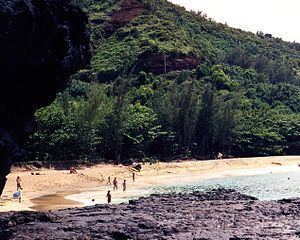Elevation 3 m | ||
 | ||
Similar Haʻena State Park, Hanalei Bay, Anini Beach, Tunnels Beach, Polihale State Park | ||
Lumaha'i Beach (Hawaiian: Lumahaʻi) is a beach located on the north shore of Kauai, Hawaii, US. Situated at the mouth of Lumaha'i River, is accessed along Hawaii Route 56 between Hanalei and Ha'ena State Park. Due to strong waves, currents and undertow, the beach and bay are considered unsafe for swimming and surfing most of the year. Bread fruit trees are said to have been planted here by a Menehune named Weli. Lumaha'i Beach was featured in the 1958 film South Pacific.
Contents
Map of Lumaha'i Beach, Hawaii 96746, USA
Geography
Lumaha'i is a picturesque beach along the northern shores of Kauai, and is formed at the mouth of the Lumaha'i River which joins the Pacific Ocean. It is accessed from Hawaii Route 56, some 1.4 miles (2.3 km) from Hanalei. Many trails emerge from the highway, which provide access to Kahalahala, the eastern end of the beach. However, the western end of the beach is accessed from an iron wood forest parking lot along the river.
The wide, sloping beach measures about 4,000 feet (1,200 m) in length, and is set against the backdrop of vertical cliffs of volcanic rocks, which have lush vegetation. The sand formation consists of olivine, a mineral consisting of the chemical composition of iron, magnesium, and silica, which renders yellowish green colour to the beach. The beach has rocky features and lava rocks at the mouth of the Lumaha'i River, which results in treacherous rip currents. As there are no reefs in the coast line, the surf is very high and strong, and sea waves are a continuous feature on the beach.
The beach plays a vital role in maintaining productivity of the estuary environment in that the features of the beach undergo changes during the year from summer to winter and during the spring season. During summer, sand dunes block the western end of the beach, creating a temporary barrier for the flow of the river into the sea and thus stabilizing the nature of the estuary. During winter and spring seasons, due to the effect of the waves and wind, the beach sand shifts drastically to the opposite eastern end of the beach. This causes a substantial reduction in the width of the beach and, combined with floods during the rainy months of spring and winter, the river flow into the ocean is restored. This phenomenon results in migration of ‘o’opu larvae (Stenogobius hawaiiensis) in large numbers, which over the next few months, as they mature, move into the estuary where they get re-acclimatized and then move upstream along the river. On account of the seasonal variations, the width of the beach changes by 350 feet (110 m). During heavy rainfall in winter and spring, the beach is prone to flooding. Because of flash floods, a phone has been installed at the beach to issue safety warnings.
Vegetation
There are three notable species of trees near the beach at the mouth of the river: the hibiscus of Maihi, the breadfruit of Weli and the pendanus of Mapuana. The pendanus of Mapuana near the beach, with the local name Kahala-o-Mapuana, unusually yielded red fruits instead of yellow and is noted for its scented smell. According to Hawaiian legend, the hibiscus of Maihi is a grove which was planted by a Menehune called Maihi-lau-koa, and the breadfruit of Weli is named after Weli, a Menehune. The Weli tree yields large fruits with plenty of pulp. Due to the tree spreading its branches to the ground, a popular verse: "Na'ulu -o-Weli punohu mai ana" meaning, "The breadfruit trees of Weli spread out their low branches like clouds" was written about it.
Public use
In the absence of a protective reef, the surf is dangerous for swimming. On account of powerful waves which break on the shore resulting in back flow, rip currents have caused drowning incidents. Specialist bodyboarders and surfers surf on the shorebreak, particularly on the eastern side of the beach where the river joins the ocean. Because of its scenic beauty with the back drop of volcanic rock cliffs and the Pacific Ocean in the foreground, the beach is a popular landscape setting among painters and for commercial photos. The beach was used in the 1958 World War II romantic movie South Pacific where a scene depicted Mitzi Gaynor singing “I'm Going to Wash that Man Right out of my Hair". In the movie, the nurses' quarters were set on Lumaha'i Beach but signed as "Nurses’ Beach".
